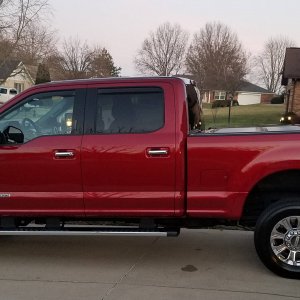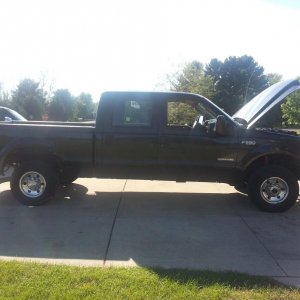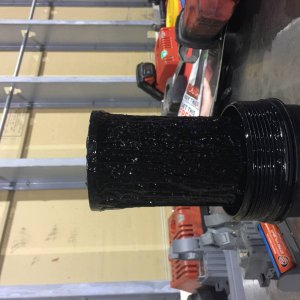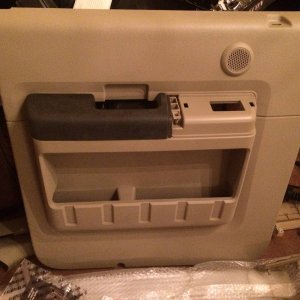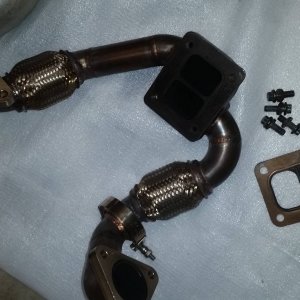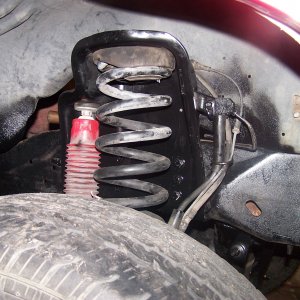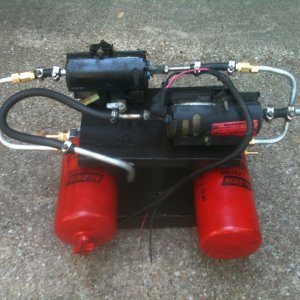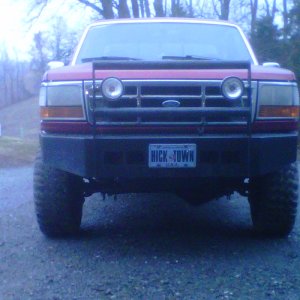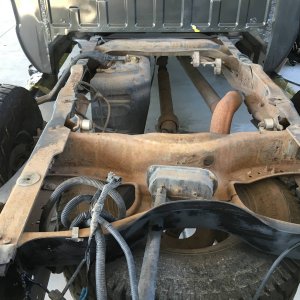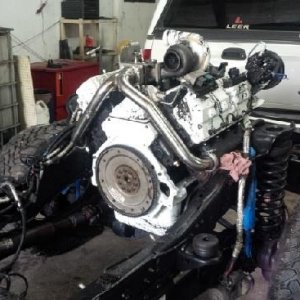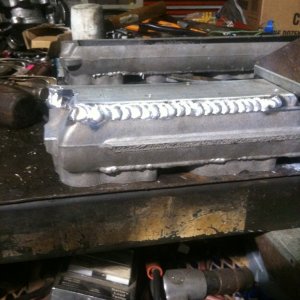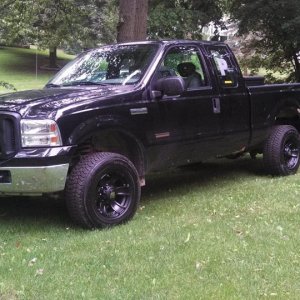You are using an out of date browser. It may not display this or other websites correctly.
You should upgrade or use an alternative browser.
You should upgrade or use an alternative browser.
Tuning 101 - Thread Merged with Injector Posts
- Thread starter Charles
- Start date
Hotrodtractor
Moderator
Wow its been awhile, thanks for the kind words! Got a message from Tim today to give this tread a peek, next thing I see is Charles talking tuning/ injectors and timing ... I had to smile. Glad to see the "old timers" still going at it!
Good to see you around and kicking.
Charles
Well-known member
- Joined
- May 18, 2011
- Messages
- 2,729
- Reaction score
- 47
Charles,
You said you were running the 200% in an 02. Is that a pmr block in there (somehow I don't think so). Sorry if I missed that info in some other thread. I have not been able to follow much of anything lately.
Sent from my SCH-I545 using Tapatalk
Bone stock PMR. Stock 4R. The only changes to the truck are the intake and downpipe it came with, injectors and 38R. The engine I'm not worried about right now sans some kind of fluke problem unrelated to the power. Anything can happen, but I'm not expecting it.
The trans I hope I have in a safe spot, but wouldn't be surprised if it popped. I lift on the shifts... Definitely not even close to full power shift capability. If it was held to the floor I would not at all be surprised if it popped before you made OD. Either the trans or converter one. Stock converter too of course. I let it lock in before I roll on the throttle, lift, then back in again on every gear if I'm trying to move out. Anything under about 75% throttle it does fine, really crisp and clean shifts actually. Amazing what a PCS can do. The pressures are maxed out though. Temps are okay so I'm not too concerned but this is definitely the first time I found myself in single digit duty cycle territory.
Only real issue I have with this truck is the driveline vibration it's had since I bought it. Never had a truck with a two-piece driveshaft before, and I don't think the previous owner got it right when they lifted it. I will eventually have to learn how to properly setup a two-piece setup and get the carrier bearing height and angle correct as I suspect that, phase, balance or a combo is the culprit.
Definitely hard to enjoy a power pull on a PMR engine with vibration under power though. Perks up all the subconscious alarms in your body about this being wrong, lol.
how does your fuel ramp differ from other tuners such as Bill? Im very interested in this.
For me, in part throttle situations loaded, heat is usually more dependent on air flow-- you match that up to the fuel, it cools and its making power. I also get the speed of the flow rate/ramp increase of a 100 vs a 200, but Im still struggling to understand how 200s would improve egts in low rpm/part throttle on low fuel files (my files with less than 2.7ms at wot). Even if you dial it back, still seems like you'd be smokey with more than you'd need. With the trailer, a tip in on the tow file can be briefly smokey. Maybe the ramp is still too aggressive for the air flow/rpm.
When the valve covers come off the next time, the injectors are likely coming out for a tuneup with 200s but I need to understand this fuel command ramp.
For me, in part throttle situations loaded, heat is usually more dependent on air flow-- you match that up to the fuel, it cools and its making power. I also get the speed of the flow rate/ramp increase of a 100 vs a 200, but Im still struggling to understand how 200s would improve egts in low rpm/part throttle on low fuel files (my files with less than 2.7ms at wot). Even if you dial it back, still seems like you'd be smokey with more than you'd need. With the trailer, a tip in on the tow file can be briefly smokey. Maybe the ramp is still too aggressive for the air flow/rpm.
When the valve covers come off the next time, the injectors are likely coming out for a tuneup with 200s but I need to understand this fuel command ramp.
Thanks guys!
Not a problem, it would probably just be easier to show you though. Its been awhile since I've needed to play so ill have to dig around for the most recent revisions. You looking for 200% stuff or 400%?
I need to know anything you could tell me about cold weather timing, pressures and such and general cold weather tuning. I never cared before, but I would like to iron out that side of my programs and guys like you have already been there and done that.
You can't exactly fog out the lady in the minivan next to you at the daycare on a regular basis and feel good about it, lol.
Not a problem, it would probably just be easier to show you though. Its been awhile since I've needed to play so ill have to dig around for the most recent revisions. You looking for 200% stuff or 400%?
Vader's Fury
Active member
Dave,
You still have the reg cab? How's it running?
You still have the reg cab? How's it running?
Charles
Well-known member
- Joined
- May 18, 2011
- Messages
- 2,729
- Reaction score
- 47
Thanks guys!
Not a problem, it would probably just be easier to show you though. Its been awhile since I've needed to play so ill have to dig around for the most recent revisions. You looking for 200% stuff or 400%?
Either. Right now I'm messing with these 200's, so if you have anything to show me there I could apply it directly.
Charles
Well-known member
- Joined
- May 18, 2011
- Messages
- 2,729
- Reaction score
- 47
how does your fuel ramp differ from other tuners such as Bill? Im very interested in this.
For me, in part throttle situations loaded, heat is usually more dependent on air flow-- you match that up to the fuel, it cools and its making power. I also get the speed of the flow rate/ramp increase of a 100 vs a 200, but Im still struggling to understand how 200s would improve egts in low rpm/part throttle on low fuel files (my files with less than 2.7ms at wot). Even if you dial it back, still seems like you'd be smokey with more than you'd need. With the trailer, a tip in on the tow file can be briefly smokey. Maybe the ramp is still too aggressive for the air flow/rpm.
When the valve covers come off the next time, the injectors are likely coming out for a tuneup with 200s but I need to understand this fuel command ramp.
It's not a matter of "fuel" ramp, in the sense that fuel is fuel is fuel is fuel anyway. The total quantity delivered can be done with massive differences to atomization and piston position/crank angle/window. With a larger nozzle usually less fuel can actually be delivered in a more timely and properly placed window that makes better use of available air, or more precisely, available TIME to do something with that air and TIME to act on the piston and TIME to finish doing both before the pressure is falling to nothing on the end of the power stroke and you're just blowing unburned fuel past the exhaust valve.
The key isn't in the absolute quantity of ICP or PW, but in the relationship or proportion of one to the other. If PW always leads ICP, which will vary for each nozzle where this point is, then the truck will ALWAYS be soft and doggy. If ICP always gets out ahead of PW, the truck will be crystal clean and snappy like a blown big block. The difference between the two is SOOOOOO small with larger nozzles. Smaller and smaller the bigger the nozzle gets because a smaller and smaller increase in duration is a larger and larger percentage increase to actual fuel delivered. And when you get the injection window too long, delivering even slightly more fuel makes problems get dumb, fast.
As a for instance....
If a truck is doggy, start pulling pulsewidth at the top end and re-sloping the map from the bottom end (assuming the pedal feels good on tip-in) so that it stays progressive from the bottom to the new lower high end values. Shallowing up the slope of the map. If you want power to come down then this will crispen and clean the truck while lowering power..... ONCE you reach the pw range that MATTERS! If you're at 7ms and you drop it to 6ms and reshape everything back to 6ms on the top end then NO..... you're not going to see the truck clean up or crispen up ANY, lol. But if you were at say 2.1 and you dropped that max value to 1.8 and reshaped between the bottom and a new top value of 1.8 then you would, with almost any nozzle, unless you were already perfectly clean and crisp. Then you would just lose power alone. In all cases you would lose power, unless you were so hideously over-doing the pw that the truck was falling on it's face and dropping oil pressure and such, then you would actually GAIN power by dropping pw!
Back on track....
If you drop pw, all else equal until the truck starts cleaning up and getting snappier you should also be dropping power. To level that out you have to plug ICP back in at the same MFD areas you're taking duration out. That keeps the fuel QUANTITY in check, while getting the injection window where it needs to be. And if you're injecting the same quantity with higher ICP..... you guessed it.... you're atomizing better too. Tighter injection window and higher injection pressure..... does it make sense why a truck would run stronger and cleaner?
Anyway, it's the proportion or relationship BETWEEN ICP and PW that determines the "attitude" of the truck.
And if you want the truck to drive nice without falling on it's face so that it has "balls" off a shift and when you drop it in gear, you have to shape the MFD table so that it's relatively steep as rpm climbs. MFD has to fall rather steeply as rpm rises and the ICP table CANNOT be allowed to rise and rpm rises else you will have a truck that's a total bitch on a shift. Just dogs right out.
If you slope the MFD down quickly as rpm rises the truck will act like a mech truck with a tight governor. The steeper you make the fall, the more you move toward an ag governor. The shallower you make the MFD, the more you move toward an automotive governor.
Charles
Well-known member
- Joined
- May 18, 2011
- Messages
- 2,729
- Reaction score
- 47
Today I had some small trusses and a small bundle of framing lumber on a 25' gooseneck. I think it was like 10 or 12 16' trusses, 40 2x4x16 and 12 2x6x10 IIRC. Not much, but something. The trailer has a tare weight of 6750. Truck is a crew cab long bed on 35's, whatever that is. Probably around 8000.
I was pulling this smallish load around the lake from 75 to 575 in ga which is very hilly.
I ran into an issue I never have before. The truck pulled so strong down low that it never really came out of OD much. I would be running uphill, passing people in OD at 60mph, which is about 1500 or 1600 rpm or so. The truck was perfectly clean and pulling perfect. Passing cars uphill, lol.
The weird part was that it was making so much power and burning so clean in the 1400 to 1600rpm range that it was driving the 38R (with the 1.15 A/R housing no less) to surge..... a LOT.....
I did not know a 38R would surge on a 7.3, much less with a 1.15 housing.... but they will.
The truck was so strong and making so much exhaust drive at 1500 or so rpm that it was driving the 38R into surge.
Thing felt like it had 900 cubes. Had that deep harmonic sound almost like a 3406 or an N14.
I'm telling you guys, the 200 is a force to be reckoned with under 600hp. The only sacrifice is idle. And that's a price worth paying considering how nice the idle can be with some attention.
I was pulling this smallish load around the lake from 75 to 575 in ga which is very hilly.
I ran into an issue I never have before. The truck pulled so strong down low that it never really came out of OD much. I would be running uphill, passing people in OD at 60mph, which is about 1500 or 1600 rpm or so. The truck was perfectly clean and pulling perfect. Passing cars uphill, lol.
The weird part was that it was making so much power and burning so clean in the 1400 to 1600rpm range that it was driving the 38R (with the 1.15 A/R housing no less) to surge..... a LOT.....
I did not know a 38R would surge on a 7.3, much less with a 1.15 housing.... but they will.
The truck was so strong and making so much exhaust drive at 1500 or so rpm that it was driving the 38R into surge.
Thing felt like it had 900 cubes. Had that deep harmonic sound almost like a 3406 or an N14.
I'm telling you guys, the 200 is a force to be reckoned with under 600hp. The only sacrifice is idle. And that's a price worth paying considering how nice the idle can be with some attention.
Last edited:
lincolnlocker
Well-known member
gol dam i love reading your posts charles!!! although ill have to read it 10 more times for it all to sink in but love it.
surging a 38r? whaaaaaat? wtf....
live life full throttle
surging a 38r? whaaaaaat? wtf....
live life full throttle
jeremiahmercier
Member
You live in ga? Man, I'd love to get with you and see if I could pick your brain, and help me guide my parent on what we should do to help their 02 (one in my sig) when towingToday I had some small trusses and a small bundle of framing lumber on a 25' gooseneck. I think it was like 10 or 12 16' trusses, 40 2x4x16 and 12 2x6x10 IIRC. Not much, but something. The trailer has a tare weight of 6750. Truck is a crew cab long bed on 35's, whatever that is. Probably around 8000.
I was pulling this smallish load around the lake from 75 to 575 in ga which is very hilly.
I ran into an issue I never have before. The truck pulled so strong down low that it never really came out of OD much. I would be running uphill, passing people in OD at 60mph, which is about 1500 or 1600 rpm or so. The truck was perfectly clean and pulling perfect. Passing cars uphill, lol.
The weird part was that it was making so much power and burning so clean in the 1400 to 1600rpm range that it was driving the 38R (with the 1.15 A/R housing no less) to surge..... a LOT.....
I did not know a 38R would surge on a 7.3, much less with a 1.15 housing.... but they will.
The truck was so strong and making so much exhaust drive at 1500 or so rpm that it was driving the 38R into surge.
Thing felt like it had 900 cubes. Had that deep harmonic sound almost like a 3406 or an N14.
I'm telling you guys, the 200 is a force to be reckoned with under 600hp. The only sacrifice is idle. And that's a price worth paying considering how nice the idle can be with some attention.
06-6.0l, studded, reworked heads, egr ******, blue spring mod, 6.4 banjos, dummy plugs, stand pipe, upgraded stc fitting, New oil cooler, New ipr, New icp, atlas 40 FICM, stage 1 powermax, and Looney wild, 325/65R18
bluedge8
Active member
Wow, I actually understood 10% of that!
ja_cain
Active member
- Joined
- Aug 10, 2013
- Messages
- 4,597
- Reaction score
- 2
Charles, you are speaking my language with these posts. The icp vs pw thing makes so much sense. Pull pw and use icp as your delivery amount knob, all while getting the fuel dilivered when the conditions are optimal (pv=nrt) and increasing fuel atomization. Its all about not wasting all of that potential energy. I posted a paper in another thread on the effects of fuel atomization on power output. I seem to remember the researcher were able to pick up 10 to 20 percent more power. I bet your cylinder pressures were pretty high at that rpm too.
Sent from my SCH-I545 using Tapatalk
Sent from my SCH-I545 using Tapatalk
ja_cain
Active member
- Joined
- Aug 10, 2013
- Messages
- 4,597
- Reaction score
- 2
I would kill to have someone like him close to me.You live in ga? Man, I'd love to get with you and see if I could pick your brain, and help me guide my parent on what we should do to help their 02 (one in my sig) when towing
06-6.0l, studded, reworked heads, egr ******, blue spring mod, 6.4 banjos, dummy plugs, stand pipe, upgraded stc fitting, New oil cooler, New ipr, New icp, atlas 40 FICM, stage 1 powermax, and Looney wild, 325/65R18
Sent from my SCH-I545 using Tapatalk
The key isn't in the absolute quantity of ICP or PW, but in the relationship or proportion of one to the other.
I didn't want to copy the whole post, but this is Perfect..
Thanks for taking the time to further share the detail of what happens when you move these parameters around. Ive loosely understood this, but never thought about it correctly. I was too focused on the direct comparison of big vs small nozzles with all else equal.
Excellent example on the 38R surge.. points out that the quality of the combustion is what really drives the turbo, not heat from a crappy overfueled event. Crap, now Ive got myself talked into these injectors coming out.. thanks man lol
V-Ref
Active member
There's an obvious market for 7.3 tuning education.
There are some pretty powerful/robust online collaboration tools now...if one or a couple of you 50lb brain tuners wanted to put some cash in your pockets, I'd help put something together that would capture your knowledge, and enable you to convey it efficiently & effectively.
How many folks would be interested in "7.3 Tuning 101" and then maybe down the road a "7.3 Tuning 201"?
It's obviously more economical to run tunes from one of the many great established tuners out there...this would be for the folks that just need to tinker
There are some pretty powerful/robust online collaboration tools now...if one or a couple of you 50lb brain tuners wanted to put some cash in your pockets, I'd help put something together that would capture your knowledge, and enable you to convey it efficiently & effectively.
How many folks would be interested in "7.3 Tuning 101" and then maybe down the road a "7.3 Tuning 201"?
It's obviously more economical to run tunes from one of the many great established tuners out there...this would be for the folks that just need to tinker
Last edited:
79jasper
Active member
That would be cool.
Sent from my SAMSUNG-SM-G890A using Tapatalk
Sent from my SAMSUNG-SM-G890A using Tapatalk
You sound just like Ty. Lol! Awesome thread resurrection, by the way! Makes me want to buy Minotaur and start messing around with it. What is your pcm code?
Sent from my SCH-I545 using Tapatalk
its the other way around.. ty sounds like charles cuz he has read everything that charles has posts about.... it is a wonderful thing to have read his info over the years..
live life full throttle
That might be partly right on both accounts but it didnt really mean dick until I started running 200% nozzles almost three years ago.
Concepts i understand because they are relevant for me.
As Charles told me several years ago, even with a 38r, a 200% nozzled little hybrid is just fine. And it is.
Dave,
You still have the reg cab? How's it running?
I do! Running well, its a bit slower after I traded for a set of 400(?)/ 200's. I was having nozzle reliability issues, any kind of issues like that had no place on a DD so they had to go.
Either. Right now I'm messing with these 200's, so if you have anything to show me there I could apply it directly.
Cool! PM me your email.
How many folks would be interested in "7.3 Tuning 101" and then maybe down the road a "7.3 Tuning 201"?
I think we had a thread like this going back in the day, we should revive that one

